Sensor Sweep: Sky Masters, Hugh Cave, H. Rider Haggard
Monday , 22, March 2021 Sensor Sweep 2 CommentsWeapons & Science Fiction (Dirk Bruere): We have all seen it — soldiers in the scifi future carrying their phasers, lasers, disruptors, blasters and so on, yet failing to hit their targets as the hero does cartwheels and back-flips to dodge the fire. The stormtroopers in Star Wars are notoriously bad shots, for example. In many ways scifi hand weapons are already outdated by the latest in contemporary guns, and the reasons why are quite simple.
Fiction (Beyond the Star Reefs): The abiding pity is that two such sterling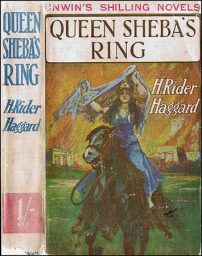 and scintillating characters could not be found a place in one of Rider Haggard’s better books. First published in 1910 by the firm of Eveleigh Nash [significantly not one of Haggard’s usual publishers] QUEEN SHEBA’S RING dates to the middle years of Rider Haggard’s career which few would advocate as being his best. The masterpieces he had regularly produced during the 1880s and 90s were long behind him, whilst the remorseless exploitation of Allan Quatermain, which would commence with the publication of MARIE in 1912, was still to come.
and scintillating characters could not be found a place in one of Rider Haggard’s better books. First published in 1910 by the firm of Eveleigh Nash [significantly not one of Haggard’s usual publishers] QUEEN SHEBA’S RING dates to the middle years of Rider Haggard’s career which few would advocate as being his best. The masterpieces he had regularly produced during the 1880s and 90s were long behind him, whilst the remorseless exploitation of Allan Quatermain, which would commence with the publication of MARIE in 1912, was still to come.
Genre (Dark Worlds Quarterly): The history of Belmont and Tower Books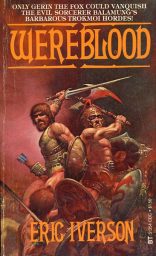 (and later Belmont Tower Books) is convoluted. Belmont Books was created by the same company that owned Archie Comics. The firm had published Pulps like Science Fiction, Future Fiction, Science Fiction Quarterly, and Dynamic Science Fiction back in the 1950s. With the Pulps dead, the company planned to publish Westerns, SF, Horror and Romance in paperback form in 1962. (Rumor has it the Belmont name came from the horse racing track.) Their SF anthologies would reprint materials from their dead Pulp titles.
(and later Belmont Tower Books) is convoluted. Belmont Books was created by the same company that owned Archie Comics. The firm had published Pulps like Science Fiction, Future Fiction, Science Fiction Quarterly, and Dynamic Science Fiction back in the 1950s. With the Pulps dead, the company planned to publish Westerns, SF, Horror and Romance in paperback form in 1962. (Rumor has it the Belmont name came from the horse racing track.) Their SF anthologies would reprint materials from their dead Pulp titles.
Fiction (M Porcius): One such book was a new book by Hugh B. Cave, who,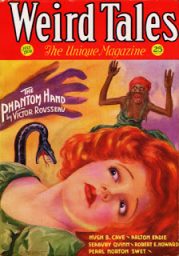 somewhat amazingly, lived to the year 2004 after being born in 1910. I borrowed this book, which I think must have been The Mountains of Madness, and was taken aback by how bad it was. Since then Cave has been on my black list, though in 2015 I offered him a parole hearing and read a 1979 story of his–the story was mediocre, and he was not granted a reprieve.
somewhat amazingly, lived to the year 2004 after being born in 1910. I borrowed this book, which I think must have been The Mountains of Madness, and was taken aback by how bad it was. Since then Cave has been on my black list, though in 2015 I offered him a parole hearing and read a 1979 story of his–the story was mediocre, and he was not granted a reprieve.
Comic Books (Bleeding Fool): Mainstream comics has now fully entered an age of woke-washing and virtue-hustling. And to continue this trend, today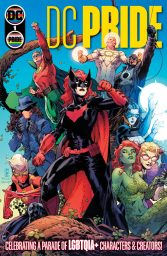 DC Comics announced DC Pride, an 80-page anthology comic featuring LGBTQIA+ characters from across the DC Universe, along with Crush & Lobo, a new eight-issue miniseries written by Mariko Tamaki. Crush & Lobo will launch on June 1 and DC Pride will publish on June 8. In this new eight-issue miniseries publishing between June 2021 and January 2022, Crush, daughter of the Czarnian bounty hunter Lobo, is in full-on self-destruct mode! After rage-quitting the Teen Titans and blowing up her relationship with her girlfriend Katie, Crush decides it’s time to finally confront her father in space jail and get her baggage sorted before she wrecks everything.
DC Comics announced DC Pride, an 80-page anthology comic featuring LGBTQIA+ characters from across the DC Universe, along with Crush & Lobo, a new eight-issue miniseries written by Mariko Tamaki. Crush & Lobo will launch on June 1 and DC Pride will publish on June 8. In this new eight-issue miniseries publishing between June 2021 and January 2022, Crush, daughter of the Czarnian bounty hunter Lobo, is in full-on self-destruct mode! After rage-quitting the Teen Titans and blowing up her relationship with her girlfriend Katie, Crush decides it’s time to finally confront her father in space jail and get her baggage sorted before she wrecks everything.
Conventions (Matthew Hopkins): WorldCon is a body that trades internationally, as the name suggests, and explicitly directs commercial activity towards Europe. For years it has harassed and discriminated against Conservatives. There is no way to do that safely here. In Britain and Europe, advocating violence against members of a political group may also amount to legally actionable discrimination. In the case of Redfearn v United Kingdom the European Court of Human Rights dealt with Mr Redfearn, a member of the BNP. Mr Redfearn was sacked from his job as a bus driver for his party membership.
Tolkien (Wade Center): Dr. Holly Ordway is a dragon-slayer. Among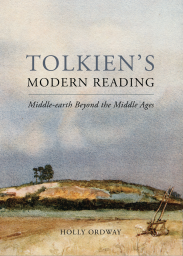 scholars, one of the fabled beasts most dangerous to challenge is the one called Conventional Wisdom. And the conventional wisdom about Tolkien is that he didn’t read much literature beyond the Middle Ages, the generation of Chaucer and the Gawain poet. With her thorough research and careful analysis, Ordway explodes this myth and creates a much more expansive and accurate picture of Tolkien’s reading habits and how they may have influenced his creative works.
scholars, one of the fabled beasts most dangerous to challenge is the one called Conventional Wisdom. And the conventional wisdom about Tolkien is that he didn’t read much literature beyond the Middle Ages, the generation of Chaucer and the Gawain poet. With her thorough research and careful analysis, Ordway explodes this myth and creates a much more expansive and accurate picture of Tolkien’s reading habits and how they may have influenced his creative works.
Plot (Amatopia): There’s a storytelling trope that I’ll paraphrase: the harder you can make your protagonist’s life, the better. Books, movies, TV shows, plays, whatever–audiences want to see their heroes succeed, but want to see them struggle to do so, to overcome seemingly insurmountable obstacles and, through skill, grit, and determination, never give up and win the day.
History (DMR Books): Richard Francis Burton is one of the odder Victorian heroes. He was born March 19, 1821, at exactly the right time to come of age within the Victorian Empire. His family were Anglo-Irish squires, the same social class that the Duke of Wellington came from. Burton was born in England, though if he could claim one Irish trait, it was a rebellious streak a mile wide. Coupled with a love of shocking respectable opinion—Burton was what the French call an épateur—he usually found himself both at odds with authority and the center of attention.
heroes. He was born March 19, 1821, at exactly the right time to come of age within the Victorian Empire. His family were Anglo-Irish squires, the same social class that the Duke of Wellington came from. Burton was born in England, though if he could claim one Irish trait, it was a rebellious streak a mile wide. Coupled with a love of shocking respectable opinion—Burton was what the French call an épateur—he usually found himself both at odds with authority and the center of attention.
Fiction (Matthew J. Constantine): Who is Kyrik? I have no idea. He’s got no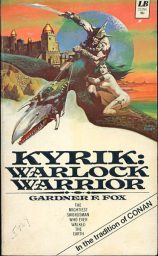 real personality. He’s big. He likes to fight. He likes to drink. He likes to bone. That’s about all there is to it. Who are the women in his life? One is hot and a bit stuffy. One is hot and free spirited. One is hot and an actual goddess. What’s the plot? Well, Kyrik was king a long, long time ago for…reasons. He was magiced into a semi-hibernation and is now out of it. In spite of it having been 1000 years since he was mobile, things are pretty much the same as when he left. Everyone knows who he is because he’s a famous legend.
real personality. He’s big. He likes to fight. He likes to drink. He likes to bone. That’s about all there is to it. Who are the women in his life? One is hot and a bit stuffy. One is hot and free spirited. One is hot and an actual goddess. What’s the plot? Well, Kyrik was king a long, long time ago for…reasons. He was magiced into a semi-hibernation and is now out of it. In spite of it having been 1000 years since he was mobile, things are pretty much the same as when he left. Everyone knows who he is because he’s a famous legend.
RPG (Wampus Country): On a regular cycle, someone complains about the death of the OSR (whether it was 2013 or 2017 or yesterday or tomorrow), and inevitably somebody chimes in talking about how things got “too commercial” and everybody in the “scene” wanted to make a buck and crank out a product. That’s worth talking about, but there are some other issues that dovetail with it that I think I need to discuss first so we get a complete picture of where I’m headed with all this.
Fiction (Fantasy Literature): I am here to tell you about still another novel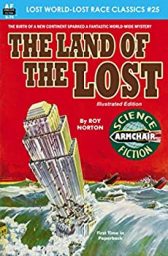 by Norton, another lost-race affair that went OOPs for a full 95 years until Armchair’s recent rescue of it. The book in question is The Land of the Lost (1909), #25 in Armchair’s ongoing Lost World/Lost Race series, and if anything, it is superior to The Glyphs in nearly every department.
by Norton, another lost-race affair that went OOPs for a full 95 years until Armchair’s recent rescue of it. The book in question is The Land of the Lost (1909), #25 in Armchair’s ongoing Lost World/Lost Race series, and if anything, it is superior to The Glyphs in nearly every department.
RPG (British Fantasy Society): Before Conan, there was Kull, Robert E. Howard’s precursor to the infamous Cimerrian. The barbarian that paved the road for Conan is formally adapted for gaming, and Modiphius’ supplement, Kull of Atlantis, allows gamers to explore the ancient past of the world of Conan. This book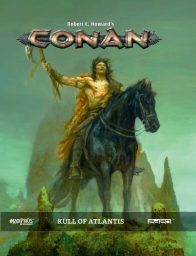 stands apart from the rest of Modiphius’ Conan line. Rather than flesh out the world of Conan, it acts as an alternate setting. The contents encompass the Thurian Age, predating the Hyborian Age of Conan. It is here that Robert E. Howard’s barbarian Kull ruled, and it is here that players can explore a completely different world, while still using the same rules.
stands apart from the rest of Modiphius’ Conan line. Rather than flesh out the world of Conan, it acts as an alternate setting. The contents encompass the Thurian Age, predating the Hyborian Age of Conan. It is here that Robert E. Howard’s barbarian Kull ruled, and it is here that players can explore a completely different world, while still using the same rules.
Fiction (Tellers of Weird Tales): My series “Utopia & Dystopia in Weird Tales” grew out of the previous series of quotes from Nineteen Eighty-Four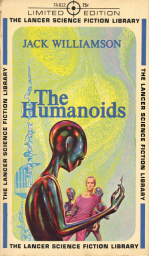 by George Orwell, We by Yevgeny Zamyatin, and the Parable of the Grand Inquisitor from The Brothers Karamazov by Fyodor Dostoevsky. After writing so much about Utopia/Dystopia, I wanted to circle back to Weird Tales, but I didn’t have any examples of either genre drawn from the pages of “The Unique Magazine.” In other words, I started something without knowing where it would go–or if it would go at all. I think I have an idea now, a thesis that I hope will hold up and carry me through to the end of this series.
by George Orwell, We by Yevgeny Zamyatin, and the Parable of the Grand Inquisitor from The Brothers Karamazov by Fyodor Dostoevsky. After writing so much about Utopia/Dystopia, I wanted to circle back to Weird Tales, but I didn’t have any examples of either genre drawn from the pages of “The Unique Magazine.” In other words, I started something without knowing where it would go–or if it would go at all. I think I have an idea now, a thesis that I hope will hold up and carry me through to the end of this series.
History (Isegoria): To expect an Asian nation accustomed to famine to feed its prisoners of war better than it own half-starved peasantry, T. R. Fehrenbach explains (in This Kind of War), was — and remains — wishful thinking: The evidence does not suggest that the Chinese deliberately tried to starve the POW’s with the end of extermination in mind, in the footsteps of the Nazis.
Fiction (Frank Ormond): Are you interested in fantasy books and want to read the classics? Which stories should you read? If you like modern fantasy and want to get into the classics of fantasy, then this list is for you. In this article I hope to break down my favorite stories of the influential tales. It’s important to note that often these stories fall between short to novella length, and that many were published in magazines then later into collections. Unlike modern fantasy, which seems to shoot for a 400 page book no matter what, the old stories were typically short enough to fit in a magazine. Keep that in mind!
RPG (Goodman Games): DCC #84.3: Sky Masters of the Purple Planet is a 6th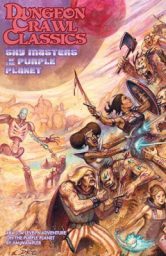 level adventure on the Purple Planet by Jim Wampler. Art is by Doug Kovacs (cover), Steve Crompton (cartography), William McAusland, and Stefan Poag. The publisher is Goodman Games. If you are familiar with the Barsoom books of Edgar Rice Burroughs, you will know that pirates on flying ships appear in Chapter VI of The Gods of Mars.
level adventure on the Purple Planet by Jim Wampler. Art is by Doug Kovacs (cover), Steve Crompton (cartography), William McAusland, and Stefan Poag. The publisher is Goodman Games. If you are familiar with the Barsoom books of Edgar Rice Burroughs, you will know that pirates on flying ships appear in Chapter VI of The Gods of Mars.
History (DMR Books): He was a Victorian force of nature; a devil-driven, raging-to-live legend in his own time. Richard Francis Burton wrote The Book of the Sword and translated the–Arabic–Book of Love. He was an anthropologist, an archaeologist, a geographer, a linguist, a poet, a mystic, a spy and a sexologist. Withal and besides, RFB still found time to be the best horseman, swordsman and pistol-shot in the British Army…when he wasn’t romancing the ladies and infuriating polite society.
Fiction (Karavansara): am reading C.S. Forester’s The African Queen, the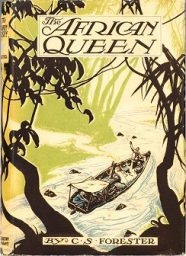 classic 1935 adventure story that in 1951 was turned into a movie by John Huston, featuring Katharine Hepburn and Humphrey Bogart. I must have seen the film a thousand times, and it remains one of the all-time great romantic adventure films, but I had never read the original novel – nor was I particularly familiar with C.S. Forester’s other books. Sure, I saw a number of adaptations of his Hornblower stories, but I had never read any.
classic 1935 adventure story that in 1951 was turned into a movie by John Huston, featuring Katharine Hepburn and Humphrey Bogart. I must have seen the film a thousand times, and it remains one of the all-time great romantic adventure films, but I had never read the original novel – nor was I particularly familiar with C.S. Forester’s other books. Sure, I saw a number of adaptations of his Hornblower stories, but I had never read any.
 Reprints (Pulp Net): On Black Friday 2020 weekend, Steeger Books put out the next set of its “Argosy Library” volumes, making up Series VIII. As always, we get 10 books of great, and sometimes overlooked, fiction that appeared in the early pulps. We get some stand-alone works, as well as volumes of various sub-series. As always, most are taken from the pulps started by Frank A. Munsey, who converted his fiction magazines to pulp paper and reduced their price, making them more profitable.
Reprints (Pulp Net): On Black Friday 2020 weekend, Steeger Books put out the next set of its “Argosy Library” volumes, making up Series VIII. As always, we get 10 books of great, and sometimes overlooked, fiction that appeared in the early pulps. We get some stand-alone works, as well as volumes of various sub-series. As always, most are taken from the pulps started by Frank A. Munsey, who converted his fiction magazines to pulp paper and reduced their price, making them more profitable.
Games (Walker’s Retreat): That’s right, the man behind Astartes got the Seal of Officialdom from Games Workshop. He, along with the folks behind The Exodite (a Tau fan film project) and another team doing one on the Iron Warriors also announced the good news yesterday. Yes, the catch is that GW now hosts the videos and some copyright-infringing elements got replaced, but this is very much a win-win situation. Not only did the film project get made official, so did everything going into it: the Retributors chapter are now official Imperial Fists successors, the xenos will be fleshed out down the road, and so on.
Warhammer (Track of Words): Dan Abnett’s trilogy of Inquisition trilogies – the Eisenhorn, Ravenor and Bequin novels – are among the best that Black Library has ever published, and certainly some of my personal favourites. With the upcoming release of Penitent, the second Bequin novel, there are now more than twenty individual stories across the overarching Inquisition series, with the nine novels (with at least one more still to come) accompanied by a dozen or so short stories. As with many Black Library series, the tricky part is knowing where to start if you’re keen to check out these stories, or where to go next if you’ve read some of them and are keen for more!
Lovecraft (Tentaculii): Possibly of interest to some, re: learning more about the historical context for Lovecraft and the Great Depression. A new book by John Marsh, The Emotional Life of the Great Depression, from Oxford University Press. Rejecting the usual approach of a ghoulish focus on ‘the despair of the 1930s’, the book explores the 1930s through other, equally essential emotions: righteousness, panic, fear, awe, love, and hope.”
Fiction (Marzaat): The story starts and takes place entirely in New York City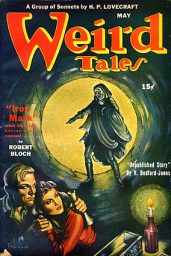 with one Roderick Thorne showing up at a dump of an apartment building to ask about one Cavet Leslie whom he is told is sick and visited daily by a doctor. The landlord refuses to let Thorne see him.
with one Roderick Thorne showing up at a dump of an apartment building to ask about one Cavet Leslie whom he is told is sick and visited daily by a doctor. The landlord refuses to let Thorne see him.
ALWAYS good to see a blog post from Richard Toogood, especially when it’s about HRH.
‘When one considers that he wrote in a period which bequeathed such an abundance of ideas and characters to posterity, from Long John Silver to Sherlock Holmes, the Psammead to the Martian tripods, – and upon which films, television and comics have been ravenously feeding ever since – Rider Haggard’s sheer creativity and influence yet elevates him above all his peers.’
My opinion, precisely. The PulpRev/App N guys REALLY need to read Haggard.
Speaking of Haggard’s influence, that Ordway book on JRRT sounds great. I have to admit, I never quite warmed to Humphrey Carpenter. Now I know why.
Nice Abnett interview.
Interesting TENTACLII post on the Great Depression. It confirms much else I’ve read about the era and what I’ve gleaned from talking to people who lived through it.
Oops. I failed to comment on the ISEGORIA post. Everything I’ve read from Fehrenbach is great. That excerpt almost could’ve been written by Robert E. Howard.